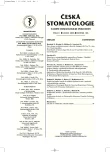Application of Laryngeal Mask for Securing Respiratory Pathways in Patient with Circumjaw Inflammation
Authors:
R. Foltán 1; J. Macháč 2; F. Donev 1; J. Hoffmannová 1
Authors‘ workplace:
Stomatologická klinika 1. LF UK a VFN, oddělení ústní, čelistní a obličejové
chirurgie, Praha
přednosta prof. MUDr. J. Mazánek, DrSc.
1; Klinika anesteziologie a resuscitace 1. LF UK a VFN, Praha
přednosta MUDr. M. Stříteský
2
Published in:
Česká stomatologie / Praktické zubní lékařství, ročník 106, 2006, 1, s. 22-26
Overview
The authors retrospectively studied the advantages, disadvantages, risk and complications in the application of laryngeal mask (LM) to secure respiratory pathways in patients with circummaxillary/circummandibular inflammation. The authors followed 23 patients at the age 19-68 years from the point of view of age of the patients, sex, size of contracture of masticatory muscles before and after diseases. LM was introduced without the application of laryngoscope and failures, i.e. repeated intubations, the use of laryngoscope, necessary endotracheal intubation, symptoms of stomach distension, regurgitation of stomach content, aspiration of stomach content and insufficient depth of anesthesia, were followed.
The study demonstrated that LM may be usedd for a safe maintenance of respiratory pathways and makes it possible to sufficient depth of anesthesia in the therapy of circummaxillary/circummandibular inflammation of odontogenic origin. LM may be applied even in conditions associated with difficut opening of mouth and potential deformities of pharynx by in inflammatory edema.
Key words:
laryngeal mask - circummaxillary/circummandibular inflammation - laryngoscopy - endotracheal intubation
Labels
Maxillofacial surgery Orthodontics Dental medicineArticle was published in
Czech Dental Journal

2006 Issue 1
Most read in this issue
- Arthralgia of the Temporomandibular Joint (Case report)
- Proliferation Activity in Pleomorphic Adenoma: Possible Prediction of Relapses
- Posttraumatic Resorption of Permanent Teeth
- Oral Health of Seniors Aged 65–74 and 75 and More Years in the Czech Republic
